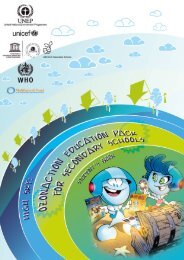Chapter 2. Progress towards the EFA goals - Unesco
Chapter 2. Progress towards the EFA goals - Unesco
Chapter 2. Progress towards the EFA goals - Unesco
Create successful ePaper yourself
Turn your PDF publications into a flip-book with our unique Google optimized e-Paper software.
PROGRESS TOWARDS THE <strong>EFA</strong> GOALS<br />
The quality of education<br />
Figure <strong>2.</strong>37: There are wide disparities across countries in primary school ma<strong>the</strong>matics performance<br />
% of fourth grade students reaching <strong>the</strong> TIMSS international benchmarks for ma<strong>the</strong>matics achievement, 2007<br />
100<br />
OECD O<strong>the</strong>r high income Middle and low-income<br />
80<br />
Highest benchmark achieved (% of students)<br />
60<br />
40<br />
20<br />
0<br />
20<br />
40<br />
60<br />
Advanced benchmark<br />
High benchmark<br />
Intermediate benchmark<br />
Low benchmark<br />
Below low benchmark<br />
80<br />
100<br />
Japan<br />
Ne<strong>the</strong>rlands<br />
England (U. K.)<br />
Germany<br />
United States<br />
Denmark<br />
Australia<br />
Austria<br />
Sweden<br />
Hungary<br />
Italy<br />
Scotland (U. K.)<br />
New Zealand<br />
Czech Republic<br />
Norway<br />
Hong Kong, China<br />
Singapore<br />
Slovenia<br />
Kuwait<br />
Qatar<br />
Latvia<br />
Kazakhstan<br />
Russian Fed.<br />
Lithuania<br />
Slovakia<br />
Armenia<br />
Ukraine<br />
Georgia<br />
Iran, Isl. Rep.<br />
Algeria<br />
Colombia<br />
Morocco<br />
Tunisia<br />
El Salvador<br />
Yemen<br />
Notes: Low benchmark – students have some basic ma<strong>the</strong>matical knowledge, an understanding of adding and subtracting with whole numbers, and can read information from simple bar graphs<br />
and tables. High benchmark – students can apply <strong>the</strong>ir ma<strong>the</strong>matical understanding and knowledge in relatively complex situations and explain <strong>the</strong>ir meaning.<br />
Source: Mullis et al. (2008).<br />
of students in Costa Rica and Cuba had moved<br />
beyond <strong>the</strong> basics. Primary school students in<br />
Cuba performed extremely well. Over 40% of Cuban<br />
grade 3 students achieved <strong>the</strong> highest reading skills<br />
assessed, more than double <strong>the</strong> share in Chile and<br />
Mexico. At <strong>the</strong> o<strong>the</strong>r end of <strong>the</strong> achievement scale,<br />
Cuba has <strong>the</strong> smallest share of students<br />
performing below <strong>the</strong> lowest grade.<br />
Countries in South and West Asia also suffer from<br />
significant deficits in levels of learning. In rural<br />
Pakistan, a recent survey found that only two-thirds<br />
of students in grade 3 could subtract single digit<br />
numbers, and only a small proportion could tell<br />
<strong>the</strong> time or carry out simple multiplication and<br />
division (Das et al., 2006). In rural India, levels<br />
of learning are equally troubling. In 2008, just 28%<br />
of grade 3 students could subtract two-digit<br />
numbers and only a third could tell <strong>the</strong> time<br />
(Pratham Resource Centre, 2008).<br />
In one important respect international learning<br />
assessments understate <strong>the</strong> problem. This is<br />
because <strong>the</strong>y cover only children in school, ra<strong>the</strong>r<br />
than <strong>the</strong> entire age group. Factoring in out-of-school<br />
children would significantly lower <strong>the</strong> scores of<br />
countries that are far from universal primary<br />
enrolment at <strong>the</strong> level being tested. In Ghana, TIMSS<br />
2007 found that 17% of 16-year-olds scored above<br />
<strong>the</strong> low international benchmark, but only around<br />
half of <strong>the</strong> children of this age were in school.<br />
This implies that only 9% of Ghanaian 16-year-olds<br />
have mastered <strong>the</strong> most basic maths skills. In highincome<br />
countries such as <strong>the</strong> Czech Republic and<br />
England (United Kingdom), most children at <strong>the</strong><br />
same stage are still in school and have far higherlevel<br />
skills in ma<strong>the</strong>matics (Mullis et al., 2008). 36<br />
Disparities in learning within countries<br />
An equal opportunity to learn is no less a human<br />
right than an equal entitlement to be in school,<br />
regardless of parental income, gender, language or<br />
ethnicity. The Dakar <strong>goals</strong> in some cases explicitly<br />
target greater equity. For example, achieving gender<br />
parity in learning achievement is an important part<br />
of goal 6 and a key component of achieving gender<br />
equality in education by 2015 (goal 5) (Box <strong>2.</strong>22).<br />
In many countries, however, large disparities in<br />
learning achievement point to deep disparities<br />
in opportunity. What students achieve is heavily<br />
influenced by both <strong>the</strong> type of school <strong>the</strong>y attend<br />
and <strong>the</strong> characteristics of <strong>the</strong>ir family backgrounds.<br />
International<br />
learning<br />
assessments<br />
understate <strong>the</strong><br />
problem as <strong>the</strong>y<br />
only cover children<br />
in school<br />
36. For <strong>the</strong> TIMSS<br />
assessment children are<br />
assessed in grade 8 of <strong>the</strong>ir<br />
education careers. In <strong>the</strong><br />
Czech Republic and England<br />
(United Kingdom) <strong>the</strong><br />
average age of children in<br />
grade 8 was 14 compared<br />
with 16 in Ghana.<br />
107
















